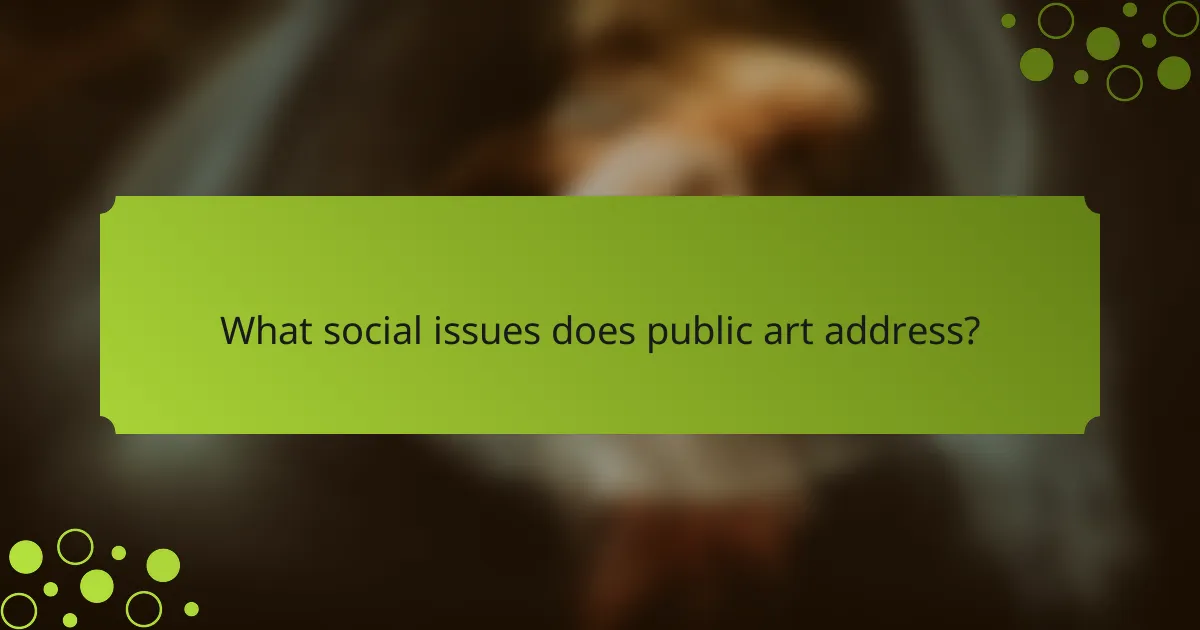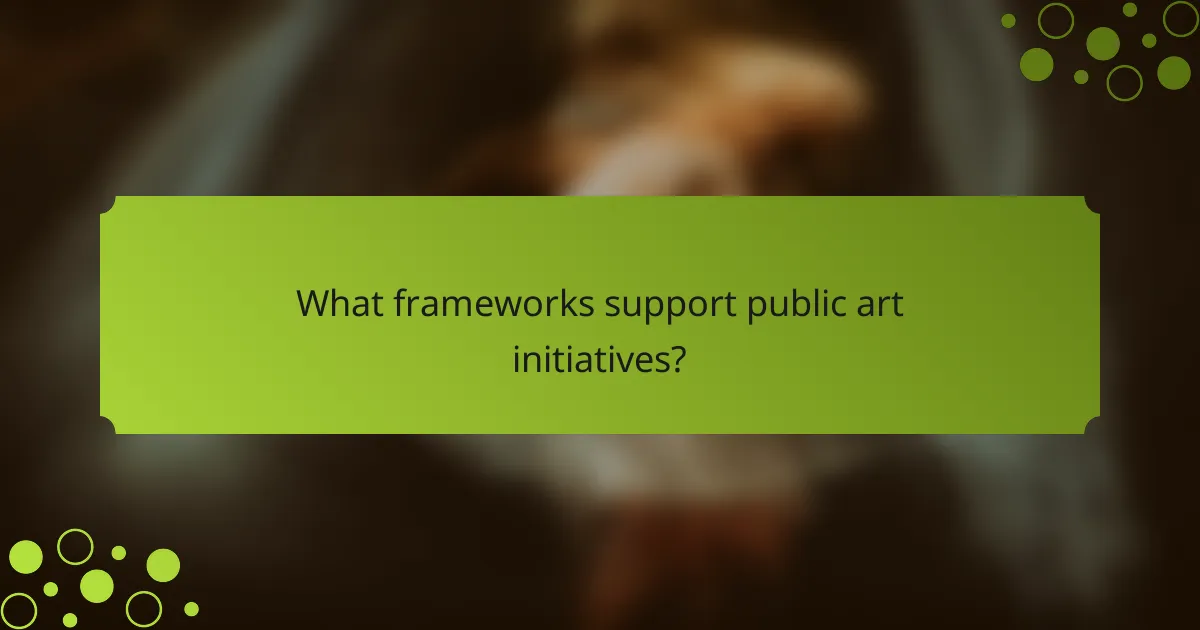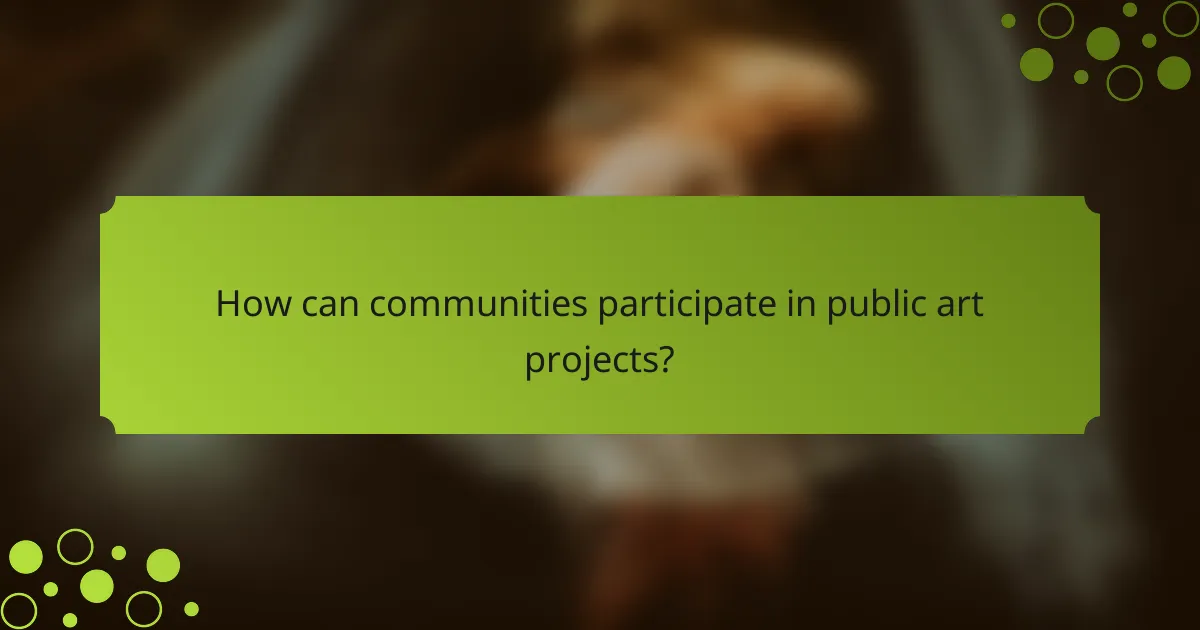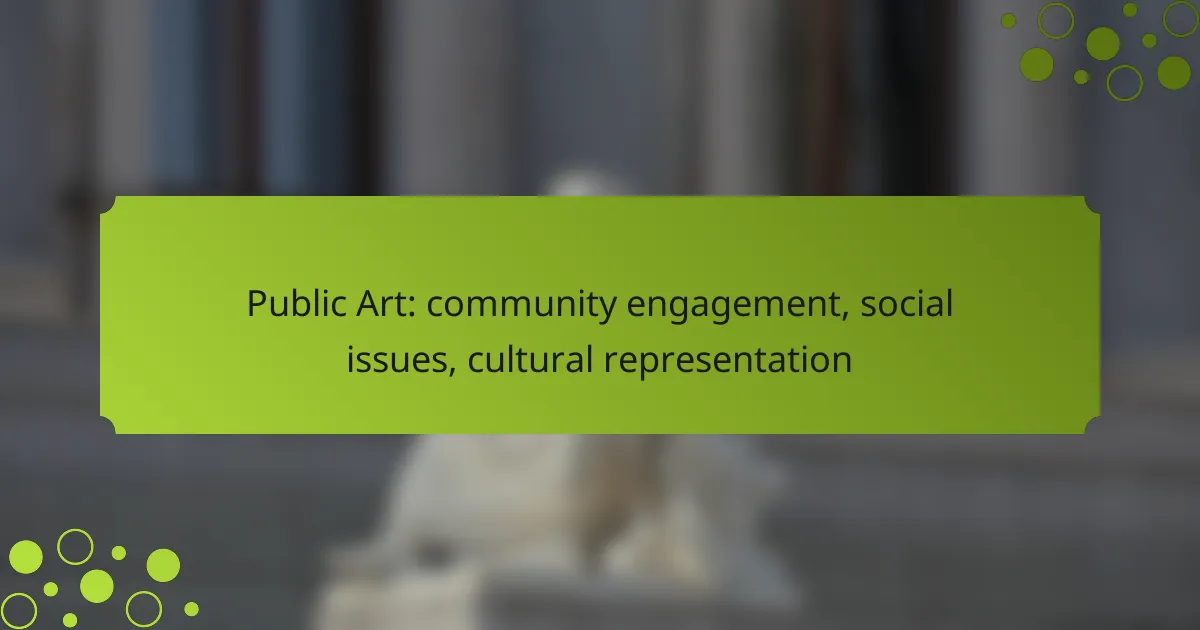Public art plays a vital role in fostering community engagement by creating shared spaces that reflect local culture and address pressing social issues. It serves as a powerful medium for dialogue, encouraging residents to connect with their environment and participate in the artistic process. Through various forms, such as murals and installations, public art showcases diverse cultural identities while prompting meaningful conversations about social justice and community challenges.

How does public art engage communities in Australia?
Public art in Australia fosters community engagement by creating shared spaces that reflect local culture and address social issues. It serves as a platform for dialogue, encouraging residents to participate in the artistic process and connect with their environment.
Community murals in Melbourne
Community murals in Melbourne are vibrant expressions of local identity, often created through collaborative efforts between artists and residents. These murals can transform neglected spaces into visually appealing areas that promote pride and ownership among community members.
Projects like the Hosier Lane murals exemplify how public art can address social issues, with themes ranging from mental health awareness to cultural diversity. Engaging local artists and residents in the design process ensures that the murals resonate with the community’s values and experiences.
Public installations in Sydney
Public installations in Sydney, such as sculptures and interactive art pieces, invite community interaction and reflection. These installations often highlight significant social themes, encouraging dialogue on topics like sustainability and inclusivity.
Events like the Sydney Festival showcase temporary installations that engage the public, drawing attention to both the art and the surrounding environment. By incorporating local materials and stories, these installations foster a sense of belonging and connection among residents.
Street art festivals in Brisbane
Street art festivals in Brisbane, such as the Brisbane Street Art Festival, celebrate urban creativity and community participation. These events bring together local and international artists, allowing them to create large-scale works that reflect the city’s cultural landscape.
During these festivals, community members can participate in workshops, watch live painting, and engage with artists, enhancing their appreciation for street art. This interactive approach not only beautifies the city but also strengthens community ties and encourages dialogue around social issues represented in the art.

What social issues does public art address?
Public art serves as a powerful medium to address various social issues, fostering community dialogue and awareness. It often highlights challenges such as homelessness, cultural representation, and social justice, prompting viewers to engage with these topics in meaningful ways.
Homelessness awareness through art
Art installations focused on homelessness can humanize the issue, encouraging empathy and understanding among the public. For example, murals depicting the stories of individuals experiencing homelessness can create a personal connection, prompting viewers to consider their circumstances.
Community projects, such as temporary art displays or interactive installations, can also draw attention to homelessness. These initiatives often involve local artists and organizations, creating a collaborative effort to raise awareness and inspire action.
Indigenous representation in public spaces
Indigenous representation in public art is crucial for acknowledging and honoring the history and culture of Indigenous communities. Artworks that reflect Indigenous perspectives can challenge stereotypes and promote cultural understanding among diverse populations.
Engaging Indigenous artists in the creation of public art not only supports their voices but also fosters a sense of pride and identity within Indigenous communities. Projects may include sculptures, murals, or installations that celebrate traditional stories, symbols, and practices, enhancing cultural visibility in urban environments.

How does public art reflect cultural representation?
Public art serves as a visual representation of a community’s cultural identity, showcasing diverse backgrounds, traditions, and social issues. Through murals, sculptures, and installations, artists express their heritage and engage the public in conversations about identity and belonging.
Multicultural festivals in Adelaide
Adelaide hosts various multicultural festivals that celebrate the city’s rich diversity, such as the Adelaide Festival of Arts and the OzAsia Festival. These events feature performances, food stalls, and art exhibitions from different cultural groups, allowing attendees to experience and appreciate various traditions.
During these festivals, public art plays a crucial role by providing a platform for local artists to showcase their work, often reflecting the themes of unity and cultural exchange. Engaging with these artworks can foster a deeper understanding of the community’s multicultural fabric.
Artworks by local Aboriginal artists
Local Aboriginal artists in Adelaide create powerful public art that highlights their cultural heritage and addresses social issues faced by Indigenous communities. These artworks often incorporate traditional symbols and stories, making them a vital part of the city’s cultural landscape.
Examples include murals and installations that depict Dreamtime stories or significant historical events. Supporting these artists not only enriches the community’s cultural representation but also promotes awareness and respect for Aboriginal history and perspectives.

What are the benefits of public art for communities?
Public art offers numerous benefits for communities, including fostering social connections, enhancing cultural representation, and addressing social issues. By engaging residents in the creation and appreciation of art, communities can strengthen their identity and promote inclusivity.
Enhances community identity
Public art plays a crucial role in enhancing community identity by reflecting the unique characteristics and values of a locality. Murals, sculptures, and installations can tell stories that resonate with residents, creating a sense of pride and belonging.
For example, a neighborhood might commission a mural that highlights its historical significance or celebrates its diverse population. This not only beautifies the area but also fosters a shared identity among residents, encouraging them to engage more with their surroundings.
Promotes local tourism
Public art can significantly boost local tourism by attracting visitors who are interested in cultural experiences. Art installations and events can serve as focal points for tourists, encouraging them to explore the area and spend money at local businesses.
Communities can leverage public art by organizing art walks or festivals that showcase local artists. Such events can increase foot traffic, benefiting shops, restaurants, and hotels, ultimately contributing to the local economy.

What frameworks support public art initiatives?
Public art initiatives are often supported by a combination of government funding programs and community partnerships with artists. These frameworks facilitate the creation and maintenance of artworks that engage communities and address social issues.
Government funding programs
Government funding programs play a crucial role in supporting public art projects. These programs can include grants from local, state, or national arts councils, which often allocate funds specifically for public art initiatives. For example, in the United States, the National Endowment for the Arts provides grants that can cover a significant portion of project costs.
When applying for funding, it’s essential to understand the eligibility criteria and application process. Many programs require detailed project proposals, timelines, and budgets. Successful applicants often demonstrate community engagement and the potential for cultural impact.
Community partnerships with artists
Community partnerships with artists are vital for the success of public art initiatives. Collaborations between local organizations, businesses, and artists can lead to projects that reflect the community’s identity and address relevant social issues. These partnerships often result in artworks that resonate deeply with local residents.
To foster effective partnerships, communities should prioritize open communication and shared goals. Hosting workshops or forums can help gather input from residents and ensure that the artwork aligns with their values and needs. Additionally, providing fair compensation for artists is crucial to maintaining a sustainable and respectful partnership.

How can communities participate in public art projects?
Communities can engage in public art projects through various avenues, including volunteering, attending workshops, and participating in forums. These activities foster collaboration between artists and residents, ensuring that the art reflects local culture and addresses social issues.
Volunteer opportunities for local artists
Local artists can find numerous volunteer opportunities to contribute to public art initiatives. These may include mural projects, sculpture installations, or community art festivals where they can showcase their skills while engaging with the community.
To get involved, artists should connect with local arts organizations or community centers that often seek volunteers for specific projects. Participating in these initiatives not only enhances their portfolio but also strengthens community ties.
Public workshops and forums
Public workshops and forums provide platforms for community members to learn about public art and share their ideas. These events often include discussions on social issues, artistic techniques, and the importance of cultural representation in public spaces.
Communities can host workshops led by experienced artists or facilitators to encourage participation. Engaging in these forums allows residents to voice their perspectives and collaborate on art projects that resonate with local values and experiences.
